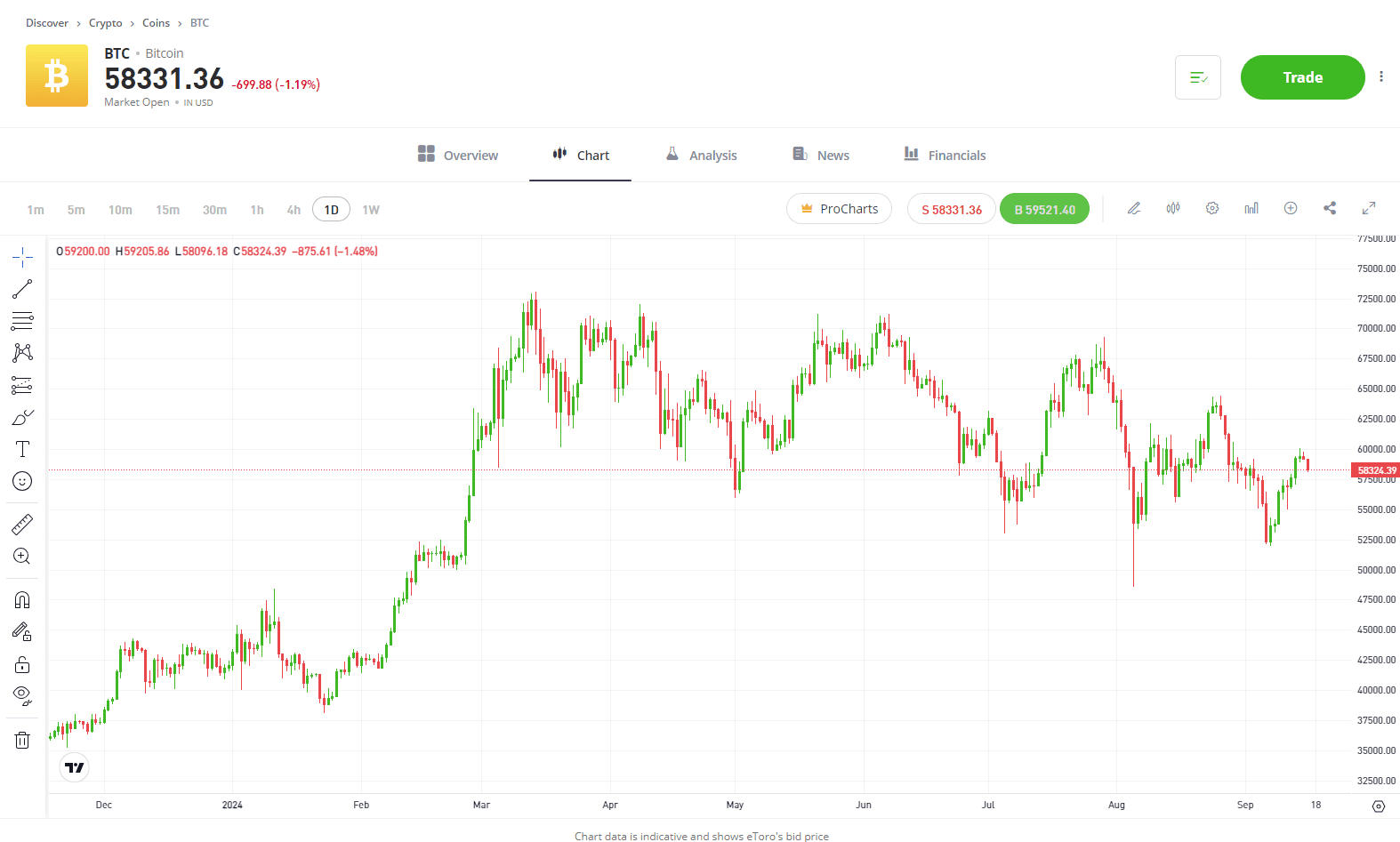Australian stocks neared all-time highs on Friday as the ASX200 gained over 1.1% for the week. The mining sector, helped by lithium stocks, lifted 4.2%, its best performance in over a year.
The S&P500 bounced back, gaining more than 4% last week after falling more than 4% the week prior. Tech stocks rallied, with Nvidia and other chip makers leading the Nasdaq higher, jumping almost 6%.
Looking ahead to this week, it’s a massive week for central banks, but all eyes are on Jerome Powell and the Federal Reserve. As of today, markets see a completely even split between both decisions, with a 50% chance of a 25bps cut and a 50% chance of a 50bps cut. Aside from the Fed, the Bank of England and the Bank of Japan will also be issuing policy decisions.
3 things that happened last week:
- China’s economy limps along
China’s CPI data rose 0.6% year-over-year, lifting from last month but still showing that the region is not doing enough to get households to spend. The struggles in China’s economy continue, and its annual growth target of 5% will undoubtedly come under pressure. It’s clear that policymakers haven’t done enough. Efforts so far have been token gestures, but we need to see more active fiscal measures for China’s economy to get going again. This number today will likely lift expectations of a rate cut in September. Consumers aren’t spending, wages are falling, and corporate profits will come under pressure. Even contrarian investors are finding it hard to build a case for investing in China right now. Until more active measures are stepped up, investors will stay clear even despite its very low valuations, with more attractive opportunities elsewhere, especially with the Fed’s rate-cutting cycle set to get underway.
- Crypto assets struggle for direct, seasonality signals better times ahead
Crypto assets have been stuck in the doldrums recently, failing to move higher after selling off on recession fears and as Former President Donald Trump loses some traction in the election race. That said, continued weakness in September amid broad weakness would likely be seen by investors as an opportunity with a seasonally strong period ahead. September is historically Bitcoin’s worst month for returns, but October and November are the best months for those returns. Therefore there may be weight behind the view of buying weakness in September with a more buoyant end to the year.

- A winner and loser last week from the S&P/ASX200
Mineral Resources reversed their fortunes from the prior week, leading the index after gaining 25%. Lithium miners were boosted following a production halt at a key mine in China.
Steadfast shares fell more than 10% for the week after shares entered into a trading halt following an ABC four corners investigation.
3 things to watch for the week ahead:
- US Retail Sales (Tuesday)
July US retail figures released in August showed heavy acceleration, jumping by 1%, the biggest lift all year. Consumers are anticipating an all-but-assured rate cut of at least 25bps come Thursday, but the balancing act comes from a weakening job market that is heavily in focus in the US, maybe not giving consumers the confidence to fully open their wallets.
That confidence is also reflected in Deloitte’s annual holiday retail forecast, showing that persistent inflation has begun to wipe out savings for many. This may dampen retailers’ hopes for a flurry of spending into year-end. US consumer credit card debt is also rising, therefore that Fed rate cut can’t come soon enough for some.
Last month’s solid reading was boosted by light vehicle sales, but those vehicle sales fell 4.4% in August, which could see a pullback in the headline number. The consensus is for retail sales to rise 0.2% year-over-year. Regardless, the US appears to have successfully avoided the threat of a recession and a soft landing (or as soft as can be) is within reach. Another rate cut after September will only further stoke consumer spending, but whether the Fed thinks this is achievable or necessary before the end of the year is another question.
- Fed Rate Decision (Thursday)
On that note, let’s talk about next week’s Fed rate call. CPI and PPI results have all but laid the groundwork for a 25bps cut next week, and although core CPI came in slightly hotter than expected, the Federal Reserve will feel confident that it is taming inflation.
A 50bps cut is still very much on the table, though. Markets see a completely even split between both decisions, with a 50% chance of a 25bps cut and a 50% chance of a 50bps cut. A big focus for the Fed moving forward will be the labour market. If the unemployment rate continues to rise, the likelihood of a jumbo cut later this year will grow.
A 25bps move from the Fed is the move they want to make and should provide a boost to equities. This move signals the Fed’s confidence in the economy and eases fears of a severe slowdown. Our base view of an economic soft landing still stands, but there is a fine balancing act between the economy slowing too fast and the Fed having to make outsized cuts down the line.
- AU Unemployment (Thursday)
Although low unemployment continues to be a concern in the RBA’s fight against persistent inflation, last month’s figures suggest the unemployment rate is heading in the right direction for the central bank to consider relieving high interest rates following its aggressive hiking cycle over the last year. July’s unemployment rate rose to 4.2% from 4.1%, but the RBA will still want to see unemployment climb to somewhere between 4.25% and 4.75% before disclosing a solid strategy that supports more than one rate cut in the next six months. Next week could show further signs of labour market cooling, with expectations for 20,000 jobs to be added and the unemployment rate to tick up to 4.3%.
The RBA’s leadership has been insistent that we’re not out of the woods yet – reaching an unemployment rate level above 4.25% remains the central bank’s goal. Although Michele Bullock was adamant that we wouldn’t see a rate cut this year, if August’s unemployment rate continues the upward trajectory, we may well see chances of a rate cut in December grow, especially with 2025’s first meeting not until the 18th of February.
*All data accurate as of 16/09/2024. Data Source: Bloomberg and eToro
Disclaimer:
This communication is general information and education purposes only and should not be taken as financial product advice, a personal recommendation, or an offer of, or solicitation to buy or sell, any financial product. It has been prepared without taking your objectives, financial situation or needs into account. Any references to past performance and future indications are not, and should not be taken as, a reliable indicator of future results. eToro makes no representation and assumes no liability as to the accuracy or completeness of the content of this publication.



